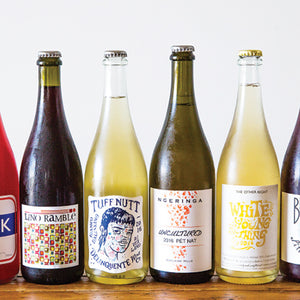
Pét-Nat
a.k.a. Méthode Ancestrale, Méthode Rurale, Pétillant Naturel
Bottle Pressure: 2–4 atmospheres (ATM) or 30–60 psi
Pét-nat is an abbreviation for “pétillant naturel”— a French term that roughly translates to “naturally sparkling.” Maybe you already knew that. After all, pét-nats have been trending for a few years now. But even if you’ve had it before, it's worth diving a little deeper to know exactly why a pét-nat is different than your traditional sparkling wine.
During the wine fermentation process, yeasts eat sugar producing two byproducts: alcohol and carbon dioxide. In still wines, all fermentation occurs before bottling so there is no trapped CO2, and therefore no bubbles. For a pét-nat, the winemaker intentionally pauses fermentation and bottles the wine before it is fully fermented. Once the wines are bottled, fermentation restarts, and since the bottles are sealed, the CO2 is trapped in the bottle. This technique is actually the earliest method of sparkling winemaking dating back centuries before traditional Champagne style wine (more on how champagne is made HERE).

Stylistically, pét-nats are fruity, fresh and slightly less effervescent that traditional champagne. Pét-nats really aren’t meant for cellaring. In general, the bubbles often become softer and smaller as the bottle ages so these are meant to be drunk within a few months of purchase. These sparklers tend to be very versatile with food as well. Most pét-nats tend to be fairly low in alcohol—usually well under 13% ABV— and so are very refreshing and great for afternoon or evening drinking.


